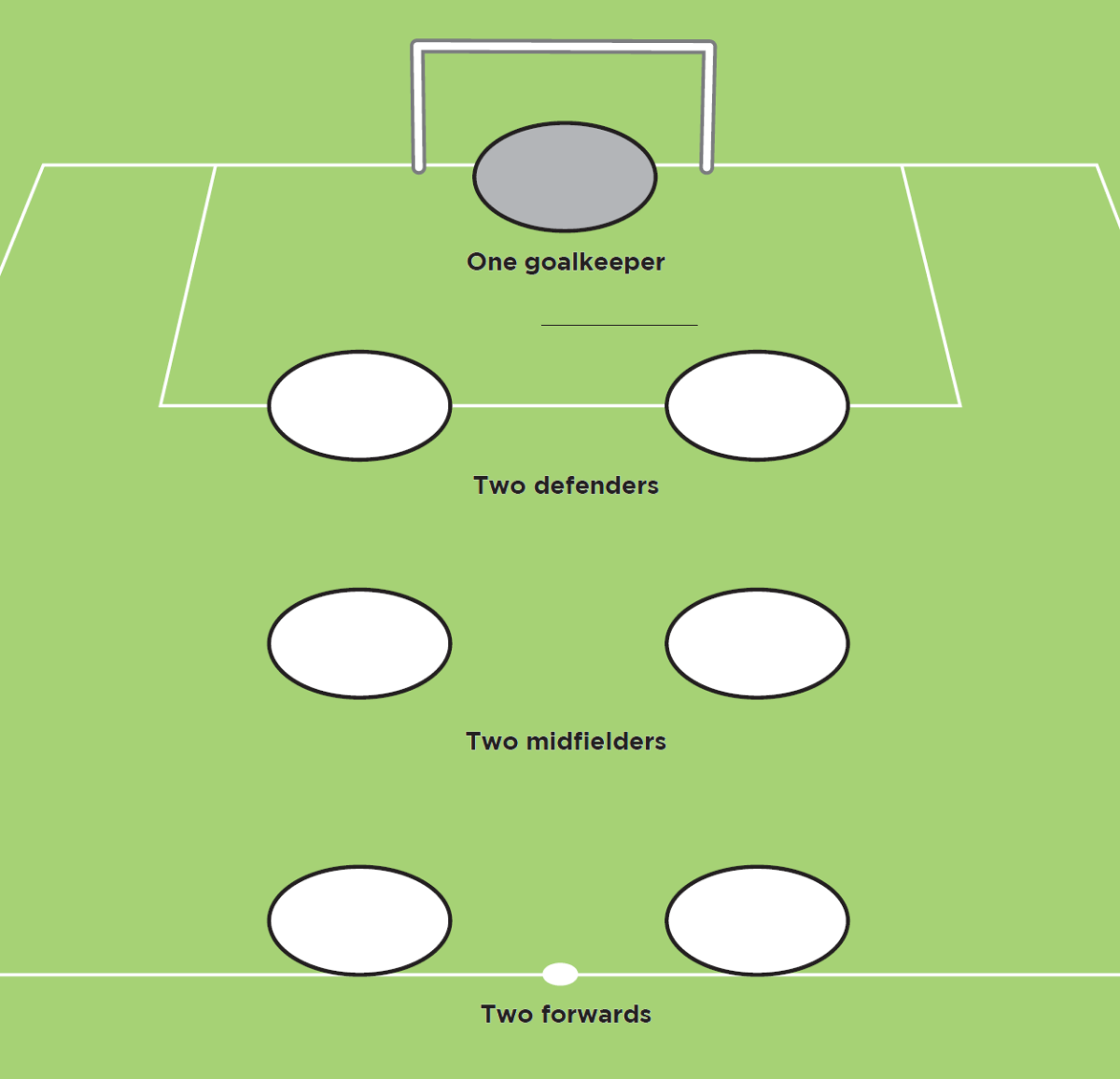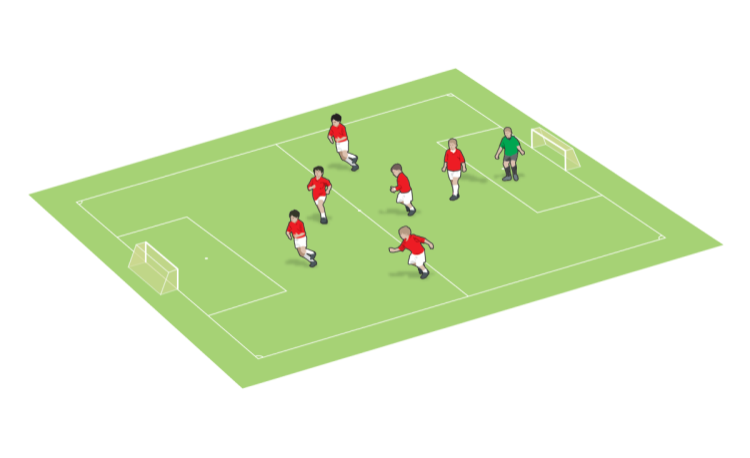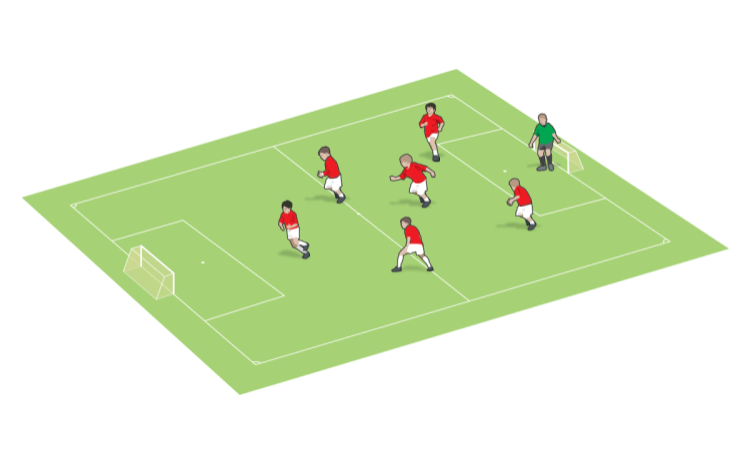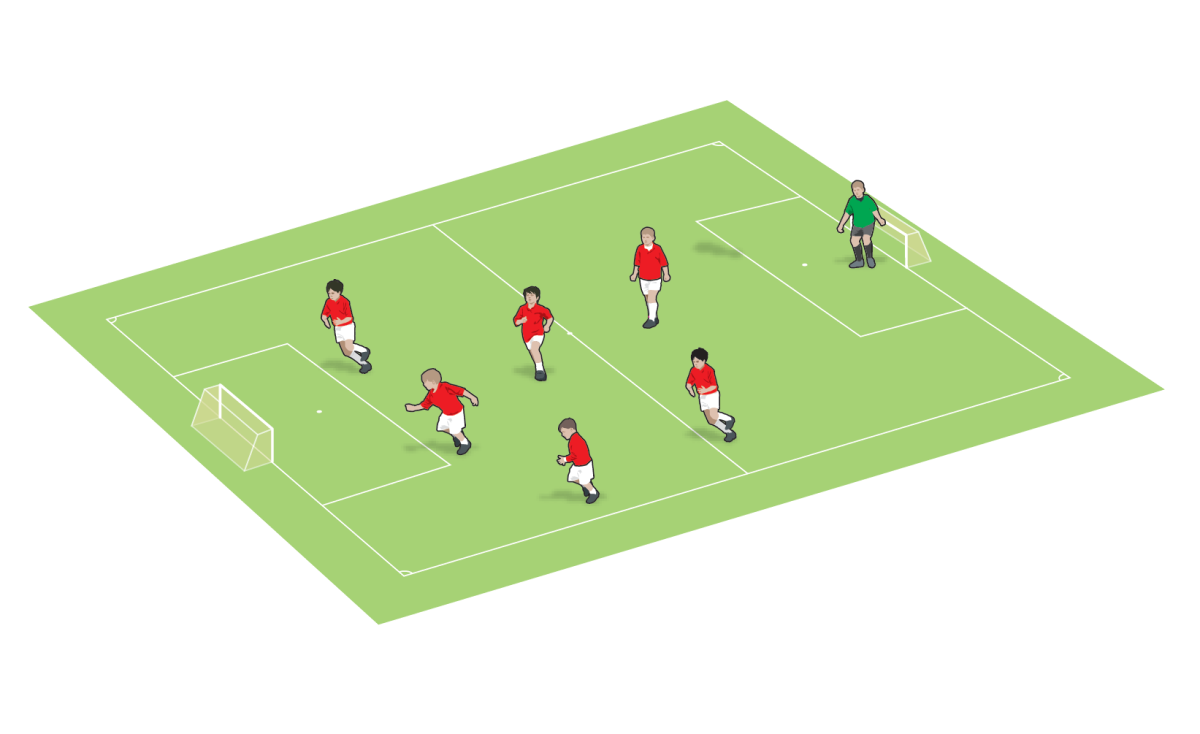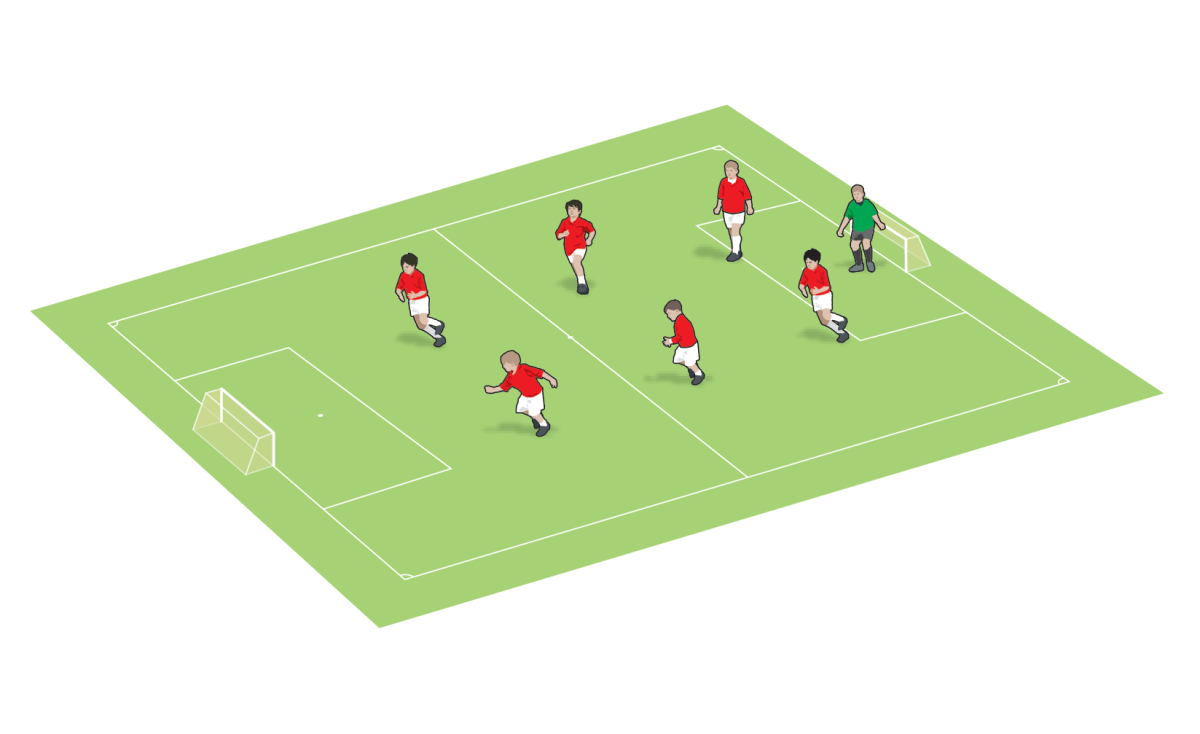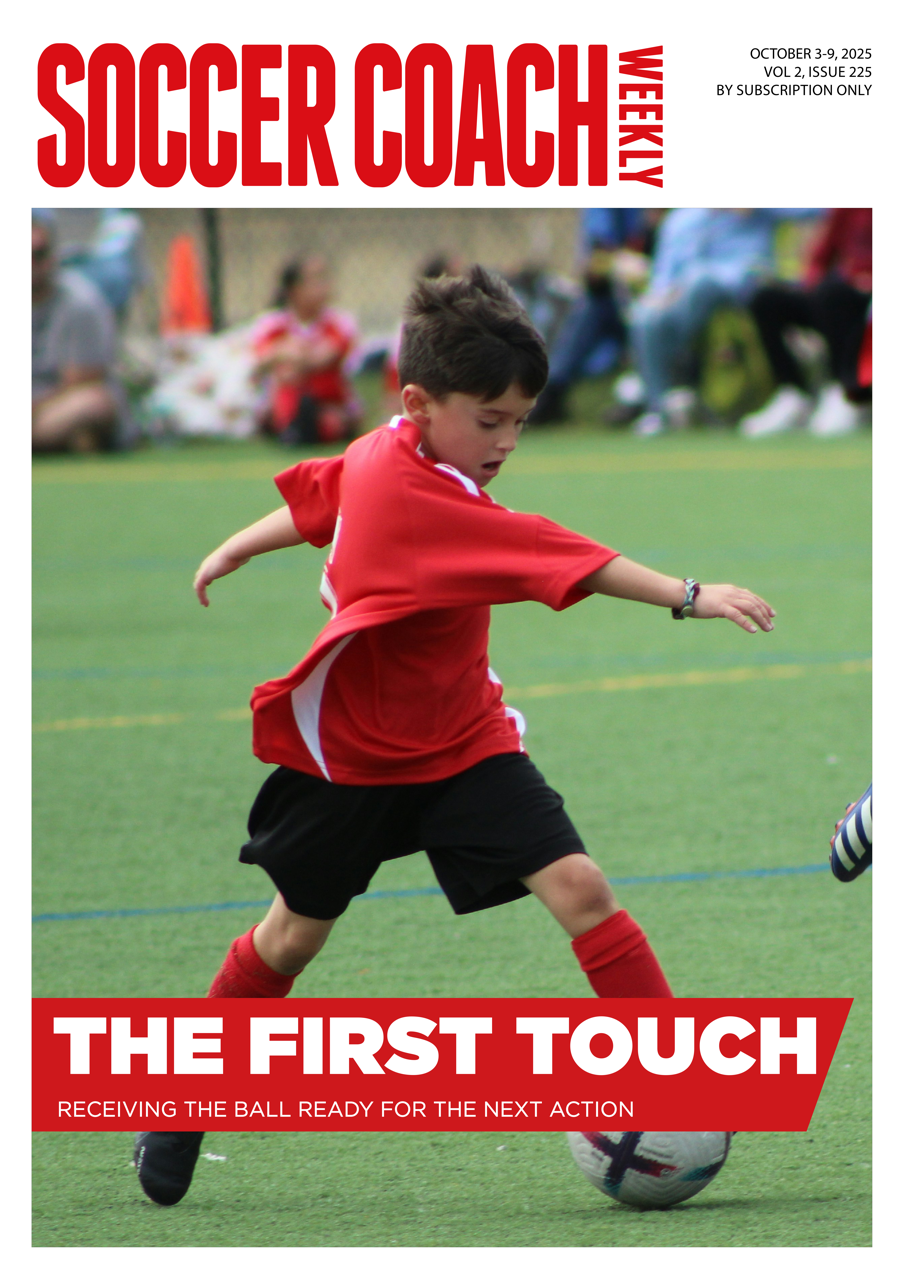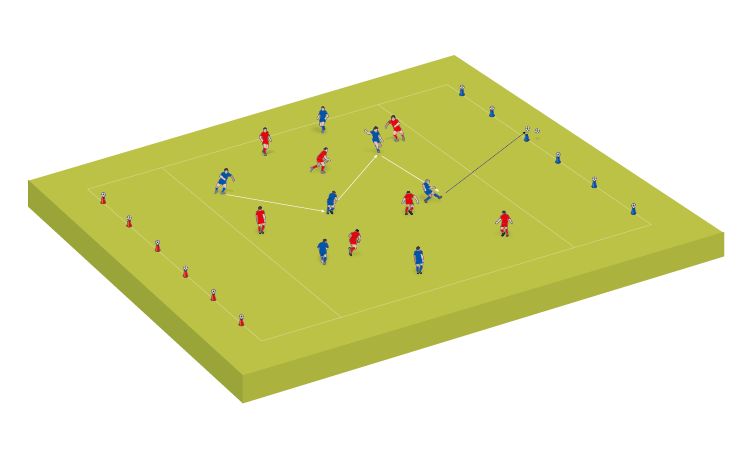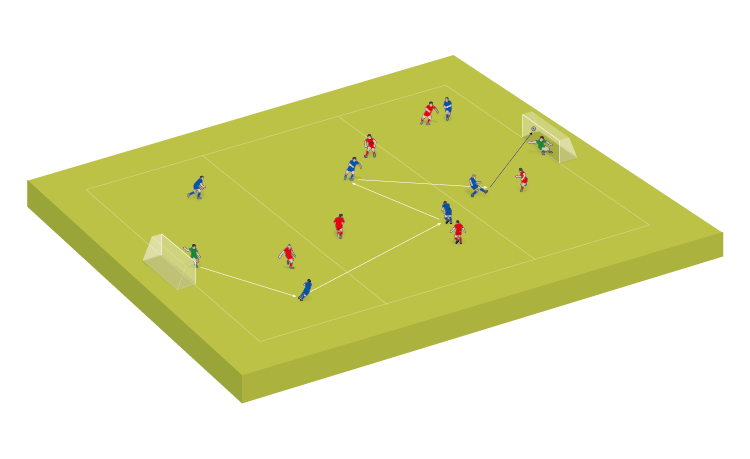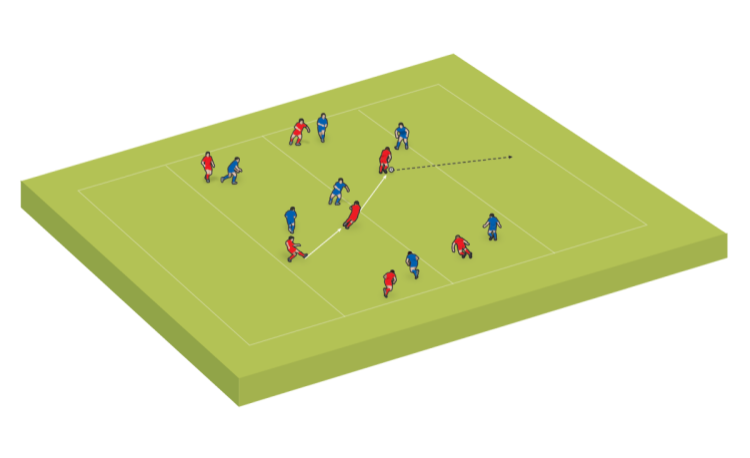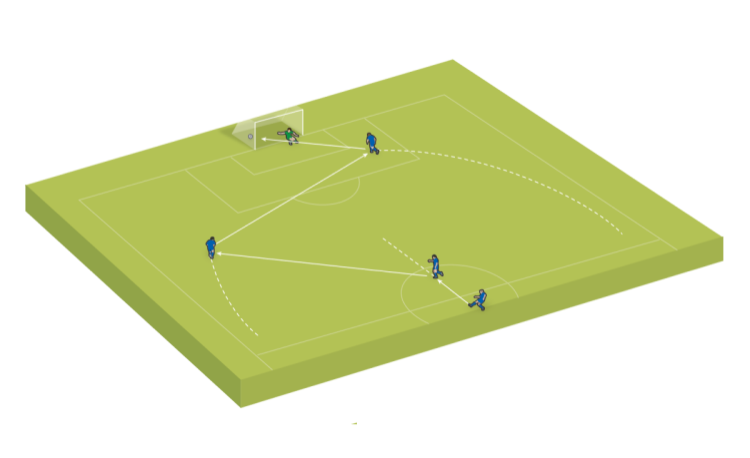7-a-side formation: 2-2-2
Why choose this 7v7 formation? Review the pros and cons, in possession and out of possession principles, and each position
Progresses from: 2-2 (4/5-a-side)
Progresses to: 3-3-2 (9-a-side)
PROS OF THIS FORMATION |
CONS OF THIS FORMATION |
|
|
|
|
|
|
|
7v7 2-2-2 - IN-POSSESSION SUMMARY
IN-POSSESSION PROS |
IN-POSSESSION CONS |
|
|
|
|
|
2-2-2 IN-POSSESSION - BY POSITION
Goalkeeper
This formation provides a goalkeeper with a range of scenarios in terms of where they need to pass the ball and how they receive it.
Because the outfield players are narrow in their set-up, width can be provided through movement from any players. This will have an impact on the type of passes the goalkeeper will have to make.
For example, if the two midfielders pull out into wide areas, this could create passing lines that allow the ball to be played directly into the two strikers.
For this pass, the ball needs to travel over a long distance quickly, to stop it from being intercepted in a dangerous area of the field. The goalkeeper will therefore need to be able to complete a low, driven pass that allows the ball to reach its intended target before an opposition player can intercept it.
The lack of width in this formation also means the goalkeeper is often likely to receive the ball from central areas.
When the ball is played into a player within the central area of the field, they will often need to bounce it back to the goalkeeper.
In a lot of other formations, the pass back to the goalkeeper will often come from a wider angle and the pressure applied by an opponent will come from a similar place.
In this formation, the goalkeeper will need to deal with straight balls being played back to them and opponents closing them down from a central position. Therefore, the goalkeeper will need to have a good first touch and be able to play an accurate pass while being put under pressure.
Defenders
When their team is in possession, the main decision the two defenders will need to make is when they must move into wide areas to provide the team with some width.
They will need to identify the position of their team-mates along with the support options that the player with the ball needs.
A good example of when they will likely need to move into a wide position is when a midfielder receives the ball in a central area.
In this instance, the defenders will also need to recognise whether the midfielder needs support behind or ahead of the ball.
Once the ball has been played, whether it is to one of the defenders or to a team-mate, the defender or defenders who do not receive the pass must reassess their positioning - are they still needed in a wide area of the pitch? Or do they need to return to a more central position?
In this formation, the two defenders will constantly need to readjust their position, even if often they will not receive the ball.
They will evolve an understanding of the need for movement to create space, either for themselves or a team-mate.
Related Files
- The two midfielders must not stand next to each other. One should come short and one must go long
- The two forwards have the opportunity to work together and look for combinations
- In this formation, goalkeepers will have a range of passing options if outfielders move
- Defenders must constantly adjust their position, especially when the team needs width
Midfielders
When playing with two midfielders, it is likely that, to begin with, both players will take up similar positions, getting in each other’s way.
This provides a really good opportunity for these players to work on their spatial awareness and ability to identify the correct areas of the pitch to move into and occupy.
The key to having two midfielders in the central area of the pitch is that they provide different options to the player in possession. This is particularly important as it is likely that most opposition teams will have just one player in this area of the pitch; therefore, the overload can be exploited.
If the two midfielders are in similar positions, it is much easier for the opposition midfield player to defend against them.
The opposition player will not have to identify which of your midfielders they think represents the biggest danger because they will be able to position themselves so they are close enough to both.
"It is likely that, to begin with, the two midfielders will get in each other’s way..."
In these situations, we can teach players about the distances between them and the importance of not being on the same line.
Rather than standing next to each other, we want the midfielders to position themselves so that one is higher up the field than their partner - that is to say, we want one to come short and one to go long.
Doing so allows the players on the ball to have two different options. Then, no matter which of the two midfielders receives the ball, they will have the opportunity to combine with each other.
Forwards
The two forwards in this formation will have the opportunity to work together and look for combinations, while also developing their decision-making, in terms of when they should dribble and when they should release the ball.
There is an emphasis on the two forwards providing the team with width. By pulling out into wide areas, it is likely that they will have a little bit more space to receive the ball. This will then affect how they receive it and what they can do with it.
When collecting the ball in central areas, it is likely that a defender will be in close proximity, thereby making it more challenging to receive to play forward.
However, by receiving in space in a wide area, the striker will be able to move forward with the ball and get themselves in a position where they can take on the defender in a 1v1 situation.
Where in particular this happens on the field will influence the other actions they will perform once they have been able to go past their opponent. For example, they might look to cross the ball or drive with it towards the goal.
The essential part is that, by the forward moving into a wide area, it will provide them with a wider range of scenarios in terms of how they receive the ball and what to do with it once they have got it.
7V7 2-2-2 - OUT-OF-POSSESSION SUMMARY
OUT-OF-POSSESSION PROS |
OUT-OF-POSSESSION CONS |
|
|
|
|
|
|
2-2-2 OUT-OF-POSSESSION - BY POSITION
Goalkeeper
Having all players in front of them in a narrow set-up means the area around the goal can become quite congested, which might result in a number of developmental opportunities for the goalkeeper.
Situations can become quite unpredictable for the goalkeeper - a shot could come at them at any time, with little warning, and, with many players positioned between them and the ball, the goalkeeper is likely to only see the ball at the last moment.
This formation will put greater emphasis on shot-stopping, as the goalkeeper will have less time to react to shots that come through a crowd of players. It is also possible that shots could get deflected, making them even more difficult to save.
Having so many players situated in front of the goal can also show the goalkeeper the need to take charge and communicate with team-mates.
A congested penalty area is a confusing one. Defenders can become hesitant and a bit rash in their decision-making and the execution of their actions.
Where possible, we want to encourage the goalkeeper to take charge of the situation and get hold of the ball.
As a coach, we can highlight the need for them to communicate with their team-mates, telling players to move out of their way and identifying which player is in the best position to deal with a particular situation.
Overall, the goalkeeper can be the solution to what can be a chaotic and frantic environment.
Defenders
As with all formations that have more than one player in the defensive unit, the main out-of-possession principles that can be worked on are the need to remain compact and to provide cover and support.
This particular formation brings additional decision-making around when defenders must leave the central area of the pitch and engage an opponent in a wide area.
Because there are not any wide players, there is more emphasis on the two defenders to close down the opposition’s wingers.
It is essential, in these moments, that the two defensive players make the right decision in terms of when they should leave their central position.
By leaving the middle of the field, they are affecting their team’s ability to remain compact and protect their goal.
But, if they do not go to press a player who is in possession in a wide area, this can also lead to problems - it might provide an opponent with time and space on the ball to drive inwards and towards the goal.
Should the opponent choose to pass or cross the ball, they are likely to be more successful if they do it under no pressure.
In this formation, it should be expected that the opposition will get some success on the flanks. It is therefore likely that the two defenders will gain experience of having to deal with balls coming in from wide areas.
As coaches, we can support the defenders to deal with crosses by getting them in the right position and having the correct body shape. A player in the correct position can often block a cross or cut it out.
Other players must also mark their opponent goal-side when dealing with crosses.
- The main out-of-possession principles that the defenders can work on are the need to remain compact and to provide cover and support
- We should challenge the two forwards to press the opposition and force them to play into the central areas, where we are numerically strong
- There are likely to be a lot of bodies between the goalkeeper and the ball, so they may see shots only at the last minute
- Midfielders must recognise when a defender has vacated their position and fill in for them
Midfielders
With the two defenders having to deal with wide players on occasion, greater emphasis will be put on the two midfielders to provide cover.
The midfielders must recognise when one of the defenders has vacated their position, leaving the team vulnerable in one of the most important places on the pitch.
When they are able to spot these moments, we want them to become a centre-back for that moment and fill in for their team-mate, who is busy elsewhere.
It is important that the two midfielders don’t both try to cover. Between them, they should recognise which one should cover and which one should stay in the midfield position. This can be whoever is closest, or whoever does it first.
Either way, once one of the midfielders covers for the defender, the other needs to recognise this and hold their position as a midfielder.
To help them be successful in these moments, we should encourage them to communicate and provide each other with information or instructions.
"In this formation, defenders will gain experience of dealing with balls from wide..."
Forwards
As with other formations at seven a-side that use two strikers, we should challenge them to press the opposition.
However, what we must recognise in this particular formation is that the opposition is likely to have an easy outlet in the wide areas. Therefore, we might ask them to press in a different way.
It is important that, at this stage, if we do ask players to press, we do not over-complicate it and overload them with lots of information.
At the same time, that doesn’t mean we cannot introduce them to some of the more basic principles of pressing.
In this particular instance, we want to try to stop the opposition from getting the ball into the wide areas. Instead, we want to force them to play it centrally, where this formation provides the team with a possible numerical advantage because of the two central midfielders.
Therefore, we can introduce them to the concept of ’trapping a team inside’ - stopping an opponent from passing to a certain team-mate by positioning one of our players between the ball and the opponent they do not want the ball to go to.
When an opposition defender is in possession, we can ask one of our forwards to cut off the pass to the nearest wide opponent, while the other forward prevents the pass from going across to the other defender.
The defender on the ball will either need to travel with it, or pass it, the into central area of the pitch, where we are numerically strong.
Once the ball is in that area, the two midfielders can hopefully take advantage of their overload and win back possession.
Newsletter Sign Up
Coaches Testimonials

Gerald Kearney, Downtown Las Vegas Soccer Club

Paul Butler, Florida, USA

Rick Shields, Springboro, USA

Tony Green, Pierrefonds Titans, Quebec, Canada
Subscribe Today
Discover the simple way to become a more effective, more successful soccer coach
In a recent survey 89% of subscribers said Soccer Coach Weekly makes them more confident, 91% said Soccer Coach Weekly makes them a more effective coach and 93% said Soccer Coach Weekly makes them more inspired.
*includes 3 coaching manuals
Get Weekly Inspiration
All the latest techniques and approaches
Soccer Coach Weekly offers proven and easy to use soccer drills, coaching sessions, practice plans, small-sided games, warm-ups, training tips and advice.
We've been at the cutting edge of soccer coaching since we launched in 2007, creating resources for the grassroots youth coach, following best practice from around the world and insights from the professional game.
